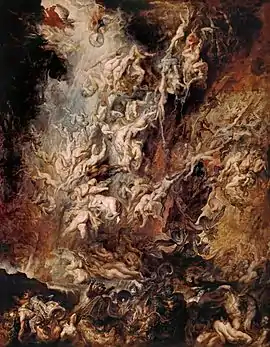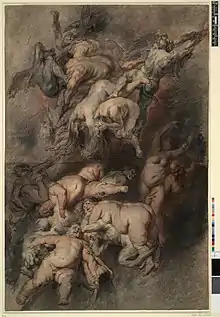The Fall of the Damned
The Fall of the Damned, alternately known as The Fall of the Rebel Angels,[1] is a monumental c. 1620 religious painting by Peter Paul Rubens. It features a jumble of the bodies of the damned, hurled into the abyss by archangel Michael and accompanying angels.[2]
| The Fall of the Damned | |
|---|---|
 | |
| Artist | Peter Paul Rubens |
| Year | ca. 1620 |
| Medium | Oil on canvas |
| Dimensions | 286.0 cm × 224.0 cm (112.60 in × 88.19 in) |
| Location | Alte Pinakothek, Munich |
In 1959, an art vandal threw acid on the painting. According to him, he did not directly destroy the work, but the acid "relieves one from the work of destruction".[3]
Sketch

The sketch of The Fall of the Damned was made in black and red chalks, with a grey wash and is kept in the British Museum. It is assumed to be the work of a studio assistant, which Rubens then went over with a brush and oil colour.[4] The dramatic chiaroscuro of the human forms and clouds emphasizes the darkness into which these figures fall, far from the heavenly light above.
References
- "Fall Of The Rebel Angels". Peterpaulrubens.org. Retrieved 2010-11-17.
- Sophie Perryer, 10 years 100 artists, Struik, 2004
- "Destructivism". Heyoka Magazine. Archived from the original on 2010-09-06. Retrieved 2010-11-17.
- "Peter Paul Rubens, drawing for The Fall of the Damned". British Museum. Retrieved 2010-11-17.